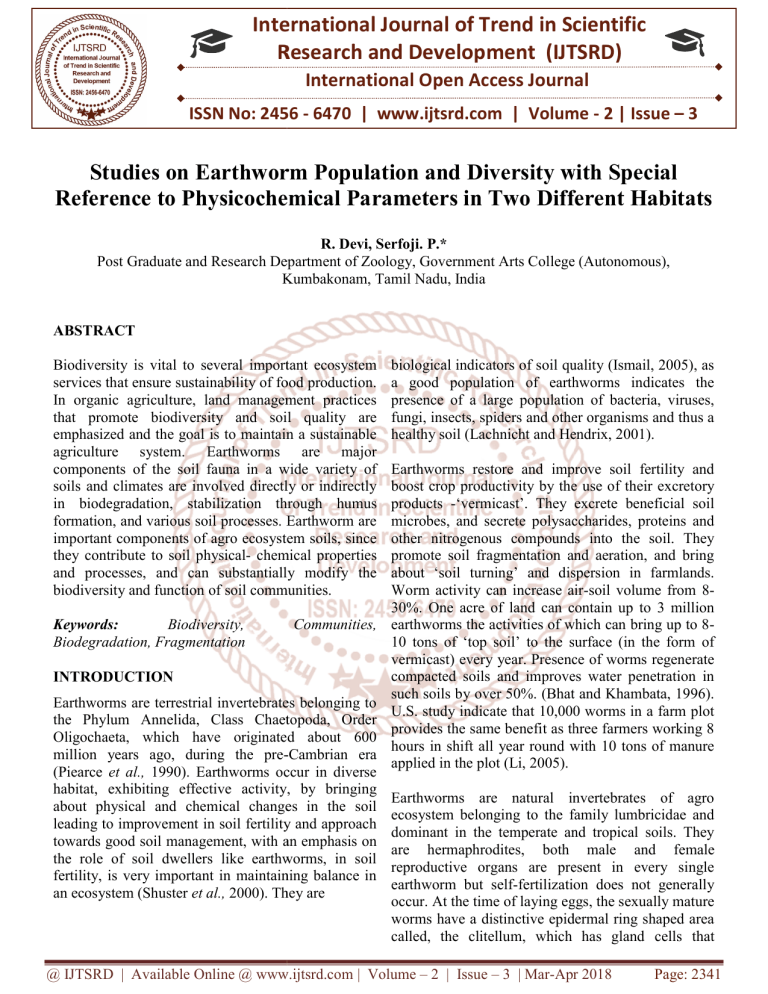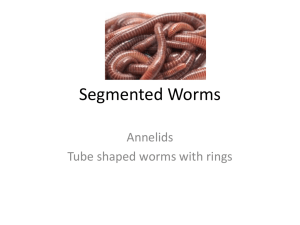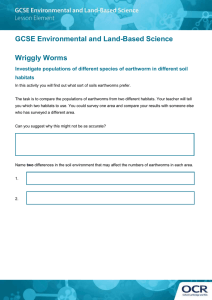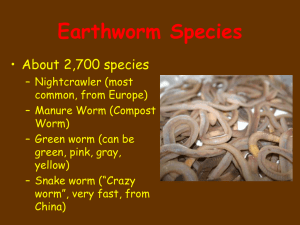
International Journal of Trend in Scientific
Research and Development (IJTSRD)
International Open Access Journal
ISSN No: 2456 - 6470 | www.ijtsrd.com | Volume - 2 | Issue – 3
Studies on Earthworm Population and Diversity with Special
Reference to Physicochemical Parameters in Two Different Habitats
R. Devi, Serfoji. P.*
Post Graduate and Research Department of Zoology, Government Arts College (Autonomous),
Kumbakonam, Tamil Nadu, India
ABSTRACT
Biodiversity is vital to several important ecosystem
services that ensure sustainability of food production.
In organic agriculture, land management practices
that promote biodiversity and soil quality are
emphasized and the goal is to maintain a sustainable
agriculture system. Earthworms are major
components of the soil fauna in a wide variety of
soils and climates are involved directly or indirectly
in biodegradation, stabilization
ilization through humus
formation, and various soil processes. Earthworm are
important components of agro ecosystem soils, since
they contribute to soil physical- chemical properties
and processes, and can substantially modify the
biodiversity and function of soil communities.
Keywords:
Biodiversity,
Biodegradation, Fragmentation
Communities,
INTRODUCTION
Earthworms are terrestrial invertebrates belonging to
the Phylum Annelida, Class Chaetopoda, Order
Oligochaeta, which have originated about 600
million years ago, during the pre--Cambrian era
(Piearce et al., 1990). Earthworms occur in diverse
habitat, exhibiting effective activity, by bringing
about physical and chemical changes in the soil
leading to improvement in soil fertility and approach
towards goodd soil management, with an emphasis on
the role of soil dwellers like earthworms, in soil
fertility, is very important in maintaining balance in
an ecosystem (Shuster et al., 2000). They are
biological indicators of soil quality (Ismail, 2005), as
a good
od population of earthworms indicates the
presence of a large population of bacteria, viruses,
fungi, insects, spiders and other organisms and thus a
healthy soil (Lachnicht and Hendrix, 2001).
Earthworms restore and improve soil fertility and
boost crop productivity by the use of their excretory
products -‘vermicast’.
‘vermicast’. They excrete beneficial soil
microbes, and secrete polysaccharides, proteins and
other nitrogenous compounds into the soil. They
promote soil fragmentation and aeration, and bring
about ‘soil
il turning’ and dispersion in farmlands.
Worm activity can increase air-soil
air
volume from 830%. One acre of land can contain up to 3 million
earthworms the activities of which can bring up to 88
10 tons of ‘top soil’ to the surface (in the form of
vermicast)) every year. Presence of worms regenerate
compacted soils and improves water penetration in
such soils by over 50%. (Bhat and Khambata, 1996).
U.S. study indicate that 10,000 worms in a farm plot
provides the same benefit as three farmers working 8
hours in shift all year round with 10 tons of manure
applied in the plot (Li, 2005).
Earthworms are natural invertebrates of agro
ecosystem belonging to the family lumbricidae and
dominant in the temperate and tropical soils. They
are hermaphrodites, both male and female
reproductive organs are present in every single
earthworm but self-fertilization
fertilization does not generally
occur. At the time of laying eggs, the sexually mature
worms have a distinctive epidermal ring shaped area
called, the clitellum, which has gland cells that
@ IJTSRD | Available Online @ www.ijtsrd.com | Volume – 2 | Issue – 3 | Mar-Apr
Apr 2018
Page: 2341
International Journal of Trend in Scientific Research and Development (IJTSRD) ISSN: 2456-6470
2456
secrete material to form a viscid, girdle like structure
known as cocoon. Cocoons are small, with their size
varying according to species. The colour of the
cocoon changes gradually as it develops from the
freshly laid stage to the hatching stage.
ge. Though the
number of fertilized ova in each cocoon ranges from
one to twenty for lumbricid worms (Stephenson,
1930), often only one or two survive and hatch
(Edward, 1967).
Earthworms are generally classified into epigeic,
endogeic, and anecic depending
ng upon different
lifestyles (Bouche, 1977). Epigeic worms live in soil
surface of 3-10
10 cm and feed on leaf litter. Endogeic
worms live deep in the soil from 10-30
30 cm and feed
on the humic materials and mineral matter, where as
anecic worms can go very deepp into soil upto 60
60-90
cm and feed on the humic materials and mineral
matter are available approximately 3600 kinds of
earthworms are found in the world and are
represented from every soil type of the globe (Verma
and Prasad, 2005).
Material and Methods
Collection of Sample – Station I
The Thiruppampuram village are located in
Thiruvarur district, Tamilnadu, India. The total
geographical area of the village is 220 hectares, the
percentage of cultivable area are 160 hectares and
respectively. This shows that
at Thiruppampuram is
predominantly an agricultural area. Agriculture is the
most important economic activity in the Thiruvarur
district, both in terms of employment and output.
Figure 1 Study Area (Station – I)
Station –II
The study area located at kumbakonam, It is an industrial and Residential area. It is a waste dumping site
used by the kumbakonam city council and environmental mainly domestic and household waste.
Kumbakonam is a municipal and second largest town in Thanjavur District, Tamilnadu.
@ IJTSRD | Available Online @ www.ijtsrd.com | Volume – 2 | Issue – 3 | Mar-Apr
Apr 2018
Page: 2342
International Journal of Trend in Scientific Research and Development (IJTSRD) ISSN: 2456-6470
2456
Figure 2 Study Area (Station – II)
The earthworms were collected from two different Identification of Earthworm
sites in paddy field Thiruppampuram village and
municipal solid waste dumping site at Kurikulam, i.
External Study
Kumbakonam. Earthworms for the taxonomic studies To study the number of metameres, setae and their
were collected and hand-sorted
sorted as per the techniques attachment pattern, pro and peristomium, position of
of Edwards and Lofty (1977). Collected worms were clitellum, dorsal pores, spermathecal apertures, male
washed in fresh water. The earthworms and soil were and female genital apertures/markings and dorsal and
stored in perforated
forated polythene bags and were brought ventral blood vessels magnifying glass and dissecting
to the laboratory for their identification.
microscope were assessed.
The alive worms were placed in an enameled tray
half-filled
filled with water, narcotized by gradually adding
ethanol to the water. When the worms became
motionless and did not respond to probing, they were
fixed for 12 hours in straightened position in another
enameled tray containing 10 % formalin. The fixed
specimens were preserved in 5 % fresh formalin in
suitable glass vials. Relaxed and straightened worms
were taken for dissection
ssection to study their external and
internal morphological characteristics. A label
indicating collection locality with region and season
accompanied in each lot of preserved worms. All
preserved specimens examined and reported in the
present work are deposited
osited our Research Institute for
further reference and study.
ii.
Internal study
It was carried out by dissecting worms
longitudinally, slightly left to right side of the middorsal line with a sharp shaving blade. Location of
internal organs (pharynx, gizzard, last pair of heart,
intestine and position of testis, ovaries, prostatic
glands and calciferous glands etc.), their presence or
absence and morphology were studied and
a recorded.
Identification of earthworm species was confirmed
by the taxonomic and monographic work of
(Stephenson, 1923; Julka and Senapati, 1987; Julka,
1988, 2001; Julka and Paliwal, 1994, Prakash, 2011).
On the basis of external and internal morphological
morpholog
characters, four genera with species of earthworms
from three Oligochaeta families were identified
Lampito mauritii (Kinberg, 1866), and Perionyx
excavatus (Perreir, 1872)) from Megascolecidae
family; Eudrilus eugeniae, (Kinberg,1866) Eisenia
foetida (Savingny
Savingny 1926) were identified from paddy
soil sites. Lampito maruitii, Perionyx excavates was
the dominant species of paddy field and dumping site
areas.
@ IJTSRD | Available Online @ www.ijtsrd.com | Volume – 2 | Issue – 3 | Mar-Apr
Apr 2018
Page: 2343
International Journal of Trend in Scientific Research and Development (IJTSRD) ISSN: 2456-6470
Eudrilus eugeniae
Eisenia foetida
Perionyx excavates
Lampito maruitii
Figure 3 Types of earthworms in paddy field
Perionyx excavates
Lampito maruitii
Figure 4 Types of earthworms in Dumping site
Table 1. Earthworm population in two different habitats
Habitat
1. Paddy field
2. Dumping site field
Name of the Species
Lampito
Perionyx excavates
maruitii
16
18
08
07
Eudrillus eugeniae
Eisenia foetida
11
02
Table1. Present study of general characters in various earthworms
Species
Lampito maruitii
Eisenia foetida
Eudrilus eugeniae
Epigeic (Exotic) Epigeic (Exotic)
Habitat’s Anecic
Night crawlers
Red worm
African
knight
Common
crawler
name
India
Europe
Africa
Native
80-120
135-140
Segments 165-190
Light brown
with Deep red
Purple pink
Colour
purplish
tingue
at
anterior side
10-21 cm
5-11 cm
8-15 cm
Length
09
03
Perionyx excavates
Epigeic
Indian Blue worm
India
130-165
Purple or reddish
brown
10-15 cm
@ IJTSRD | Available Online @ www.ijtsrd.com | Volume – 2 | Issue – 3 | Mar-Apr 2018
Page: 2344
International Journal of Trend in Scientific Research and Development (IJTSRD) ISSN: 2456-6470
Weight
1.0-2.5 g
0.9 mg
1.5-2.5 g
1.7-2.0 g
Feeders
Deep feeders (10-30 cm)
Surface feeders
(3-10 cm)
Surface feeders(3-10
cm)
Surface feeders (310 cm)
RESULT AND DISSCUSSION
In the present study an attempt has been made to
know the distribution and relative abundance of
earthworms in Thiruppampuram village and dumping
site from Kurikulam. The biodiversity of earthworms
were analyzed related to their habitats considering
species identification and richness of earthworm
species in two different fields. Earthworm species
were collected and identified generally according to
their morphological characteristics, habitats and size.
Four species such as Perionyx excavates, Eudrilus
eugeniae, Eisenia foetida and Lampito maruitii were
identified from paddy soil sites. Lampito maruitii,
Perionyx excavates was the dominant species of
paddy field and dumping site areas. The lowest
abundant species were Eudrilus eugeniae and
Eisenia foetida found in only paddy field.
Physico-Chemical parameters were analyzed the
collected soils and soil texture was found Loamy and
Silty soil. Different chemical parameters of the soil
such as pH, N, P, K (Macro nutrients) and Fe, Mn,
Zn, Cu (Micro nutrients) concentration was tested
which was related to the abundance of loamy and
silty soil. Highest earthworm abundance was
recorded in paddy field. Where the soil was tested
Sl. No
1.
2.
3.
4.
5.
6.
7.
8.
9.
chemical conventions were good quality. On the
other hand the lowest abundance of earthworms was
observed in dumping site the soil was tested
chemical conventions was low quality. The
physicochemical, nutritional and biochemical
parameters were observed in the soil were tested
from ICAR institute of Aduthurai.
Earthworms are regarded as ‘biological indicator’ of
soil fertility and a ‘soil conditioner’. They lead to
total improvement in the physical (soil porosity and
softness), chemical (good pH and essential plant
nutrients) and biological (beneficial soil microbes
and organisms) quality of soil and land where they
inhabit. They swallow large amount of soil with
organics (microbes, plant and animal debris)
everyday, grind them in their gizzard and digest them
in their intestine with aid of enzymes. Only 5-10
percent of the chemically digested and ingested
material is absorbed into the body and the rest is
excreted out in the form of fine mucus coated
granular aggregates called ‘vermicastings’ which are
rich in NKP (nitrates, phosphates and potash),
micronutrients and beneficial soil microbes (Scheu,
1987).
Table 2: Physico chemical parameters of two different sites
in Thiruppampuram Village and Karikulam
Parameter
Thiruppampuram Village
Karikulam
Silty soil
Loamy soil
Silty soil
Loamy soil
PH
EC(dSm-1)
Nitrogen (N) (%)
Phosphorous (P) (%)
Potassium (K) (%)
Iron (I) (ppm)
Manganes
(ppm)
Zinc (Zn)
Cupper (Cu)
7.4
0.16
60.2
67.0
80
7.0
(Mn) 1.3
1.0
0.5
7.2
0.08
70
75
71.2
7.3
3.4
8.0
1.9
50.8
60
20
6.0
1.0
8.1
0.13
61.6
34.5
45
6.4
1.7
2.3
1.0
1.0
-
2.6
0.5
@ IJTSRD | Available Online @ www.ijtsrd.com | Volume – 2 | Issue – 3 | Mar-Apr 2018
Page: 2345
International Journal of Trend in Scientific Research and Development (IJTSRD) ISSN: 2456-6470
CONCLUSION
Present survey indicates the presence of four species
of earthworms belonging to two different families of
Lumbricidae, Megascolecidae in two different parts
4.
of Thiruppampuram village, and dumping site are of
Kurikulam at Kumbakonam. The texture of soil has
great influence on the distribution and population
structure of earthworms is higher in paddy field at
5.
thiruppampuram village. Studies on different region
of the globe and on different ecosystem have
revealed that the earthworm diversity is highly
6.
variable owing to geographical region, climatic
condition and disturbances in habitat concerned. The
manipulation of natural habitat by anthropogenic
activities has resulted into displacement of
earthworm species.
7.
REFERENCES
1. Bhat, J.V. and P.Khambata (1996). Role of
earthworms in agriculture. Pub. of Indian
Council of Agriculture Re-search (ICAR), 22,
New Delhi, India, 36.
8.
2. Bouche, M.B (1972). Lombriciens de France.
Ecologie et Systematique (Paris: Institute
National de la Recherches Agriculturelles.
3. Capowiez, Y., S. Cadoux., P. Bouchand., J.
Roger-Estrade., G. Richard and H. Boizard 9.
(2009). Experimental evidence for the role of
earthworms in compacted soil re-generation
based on field observations and results from a
semi-field experiment. Soil Biology &
Biochemistry, 41(4), 711-717.
Edwards, C.A. and E.F Neuhauser (1988).
Earthworms in waste and Environmental
Management. SPB Academic Press, The Hague,
the Netherland.
Edwards, C.A. and J.P. Bohlen (1967). Biology
and Ecology of Earthworms, 3 edn, Chapmann &
Hall.
Ismail, S.A., (2005). The Earthworm Book.
Other India Press, Mapusa, Goa. 101p. Benedek
P (1972) Possible indirect effect of weed control
on population changes of wild bees pollinating
lucerne. Acta Pathol Acad Sci Hung 7:267–278.
Julka, J.M. and B.K. Senapati (1987). Records
of Zoological Survey of India: Earthworms
(Oligochaeta: Annelida) of Orissa, India.
Miscellaneous Publication (Occasional Paper
No.92), Published by the Director, Zoological
Survey of India, Calcutta.
Julka, J.M., (2001). Distribution of earthworms
in different agro-climatic regions of India.
Workshop on Tropical Soil Biology and fertility
programme. School of Environmental Science,
Jawaharlal Nehru University, New Delhi, p.1-12.
Julka,J.M. and R.Paliwal (1994). On a new
species of Plutellus Perrier (Acanthodrilidae:
@ IJTSRD | Available Online @ www.ijtsrd.com | Volume – 2 | Issue – 3 | Mar-Apr 2018
Page: 2346
International Journal of Trend in Scientific Research and Development (IJTSRD) ISSN: 2456-6470
Oligochaeta) from northwest Himalayas, India.
Research Bulletin of the Punjab University
(Science), 44:217-220.
10. Li, K.M. (2005). Vermiculture Industry in
Circular
Economy,
Worm
Digest.
http://www.wormdigest.org/con tent/view/135/2/
11. Prakash,O., (2011). Evaluation of population
density and diversity of earthworms in two agroecosystems in some regions of Uttar Pradesh with
emphasis
on
solid
waste
management.Ph.D.Thesis submitted to Mahatma
Jyotiba Phule Rohilkhand University, Bareilly
(India).p.1-105.
12. Scheu, S. (1987). Microbial activity and nutrient
dynamics in earthworms casts. Journal of
Biological Fertility Soils, 5(3), 230-234.
13. Shuster, W.D., S. Subler and E.L. McCoy
(2000). Foraging by deep-burrowing earthworms
degrades surface soil structure of a fluventic
hapludoll in Ohio. Soil and Tillage Research, 54:
179-189.
14. Stephenson, J. (1914). On a collection of
Oligochaeta mainly from Northern India.
Records of the Indian Museum, 10: 321-365.
15. Stephenson, J. (1923). The Fauna of British
India including Ceylon and Burma. Oligochaeta.
Taylor and Francis, London, 518pp+XXIV.
@ IJTSRD | Available Online @ www.ijtsrd.com | Volume – 2 | Issue – 3 | Mar-Apr 2018
Page: 2347




